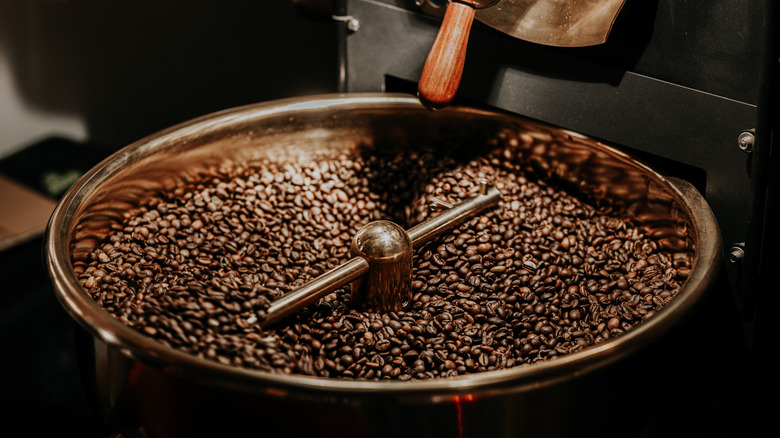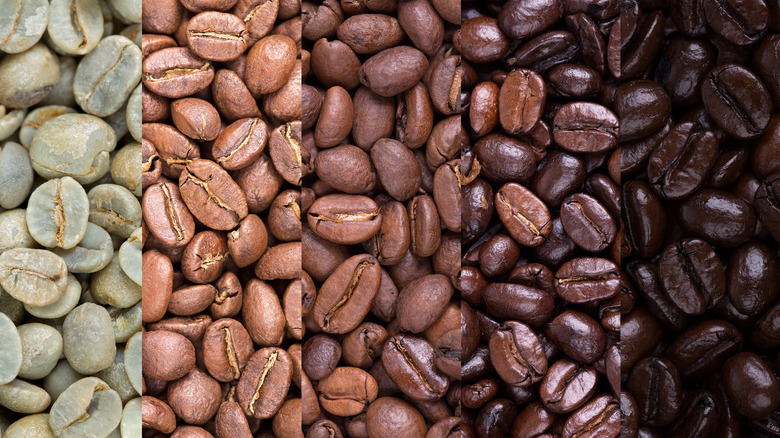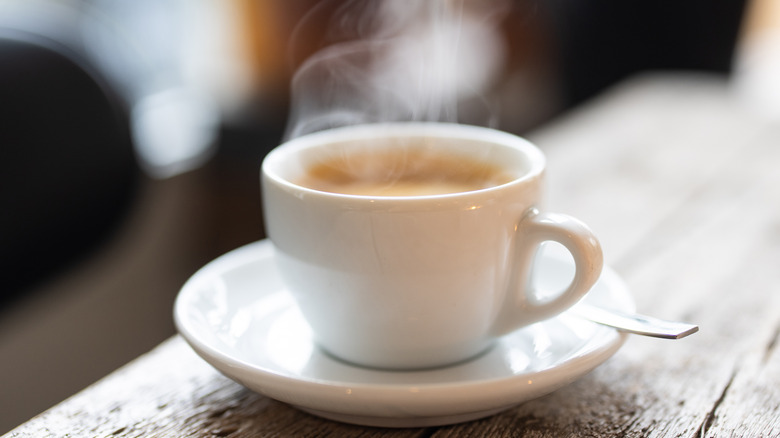How French Roast Coffee Gets Its Smoky Flavor
In the wake of the third-wave coffee movement, it's easy to pass over classic French roast coffee in favor of blonde or medium roasts. The French style is heavily roasted, placing it firmly at the dark end of the spectrum. But just like charring food isn't the same as blackening it, dark roasts are not all burned beans and charcoal.
To achieve the trademark campfire aroma, the beans are cooked at temperatures between 440 to 467 degrees Fahrenheit and can take nearly 20 minutes depending on the process. Coffee roasters track the beans' progress by listening for two cracking sounds, which indicate that first the steam inside the bean has heated and popped the pod's shell, and, second, that carbon dioxide has been released and the beans are breaking down. This intense heat and time cause the beans to literally smoke and go from browned and caramelized to almost charred — almost being the operative word.
The heat draws out the oils in the bean, resulting in shiny pods and a cup of Joe with more body. As such, the brew is heavier and distinctly smoky, lacking the citrus notes and tart acidity of light roasts. Similar to arguments that Starbucks coffee has a burnt taste, the purposefully heavy hand taken by roasteries can make this roast of java somewhat divisive.
Today's French roast coffee beans
Many of today's coffee companies take pride in their process, approaching the intense heating process with creativity to surprise or even challenge their customers' palates. Since there's no standardized designation for French roast, the variations in bean origins, cook times, and temperatures can produce a range of beverages. Though technically you can measure how toasty it is based on the pod color, there isn't a single standard enforced across producers.
Although some coffee aficionados argue that the intense heat cooks out any distinctive regional flavors or terroir, defenders of the distinctive dark roast enjoy tasting the chocolatey, fruity, or nutty notes. And some manufacturers do take the intensive process into account as they choose a bean or blend to heat. Slow-growing pods that are farmed at high altitudes in South America often get a nod, as they're compact and can stand up to the grueling 'second crack.' Indonesia and Ethiopia also make frequent appearances.
And there's another component to French roast coffee that's very important in New Orleans: chicory root. Big Easy residents took the rich drink, and the French penchant for adding the natural sweetener, and made it their own. The balancing ingredient is an essential component in the iconic orange tins at Cafe Du Monde and shows off the warmth of the brew style.
Elevate your smoky cup of Joe
Nothing beats a classic, and when it comes to French roast coffee, that means café au lait. Similar to a latte or café con leche, the beverage is a mixture of brewed coffee and steamed milk. Like espresso, another heavily heated bean, the brew shines when taken with cream — or your dairy alternative of choice. We suggest a luxurious pour of coconut milk, as the flavor will pair nicely with the slightly chocolatey notes of the coffee.
If you're hoping for a sweeter, bolder beverage, consider making Vietnamese coffee. The drink is brewed in a phin, a tool with components that press ground beans and allow hot water to filter and drip into a concentrated liquid. The dark roast is then flavored with sweetened condensed milk, drawing out its molasses and cocoa notes.
To amplify the smoky, chocolaty, and spiced notes, you could also prepare café de olla. The Mexican drink features cinnamon, dark coffee, and piloncillo, a sweetener similar to brown sugar. Some iterations include clove, star anise, and a little cream to bring the mixture together after you brew it on the stove and strain it.



